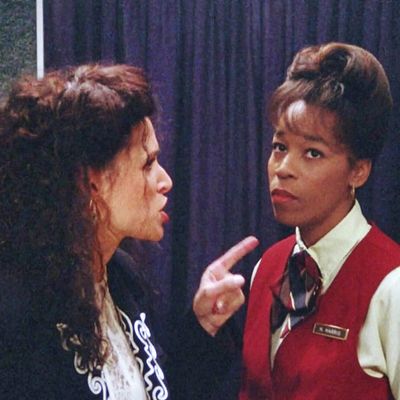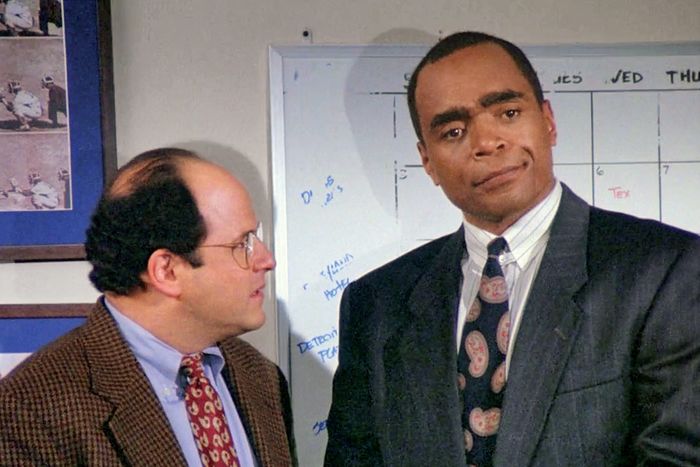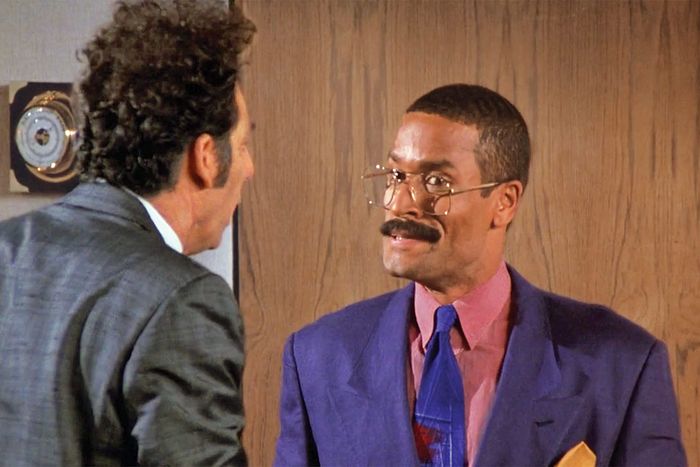
White sitcoms have of late united, disavowing the misbegotten race play of television’s recent past. Contrary to prior negligence, shows such as Scrubs and 30 Rock have pulled episodes featuring blackface from streaming platforms as a way of making amends. Even episodes like It’s Always Sunny in Philadelphia’s “Dee Reynolds: Shaping America’s Youth,” which cracks wise about the absurdities of racial performance, got the ax. I was something akin to relieved upon my Seinfeld rewatch to find Michael Richards’s scorched visage, grinning like Sambo, still intact on the episode “The Wife.”
Exorcisms are boring these days — that is, exorcisms of a PR sort, which give the impression that race arrives only when we perceive it and evaporates with every redacted slur. After all, the American sitcom, like so many national institutions, has an earned reputation for segregation. There are the vaunted Black classics and then there are the shows that are containers for white stories, which present an urbanscape — usually New York City — whose multiculturalism goes unseen.
But Black people have never been nonexistent, or invisible, in the white sitcom. They have been invisible only in the way that Black people who service the margins of white world-making must be. In a genre whose conventions (and hilarity) thrive on white ridiculousness, Black people, relegated to the smallest of parts, exist to rein in the free play of whites, reminding viewers how safely deviant the main cast can be. No show exhibits this effect as quietly as the one that crested in lockstep with the ’90s culture wars, the quintessential sitcom and, in one woman’s opinion, the greatest — Seinfeld.
I speak of certain characters often deprived of a name:
The Florist (Lionel Mark Smith in “The Gum”); the Agency Rep (Victoria Dillard, “The Old Man”); the Orderly, who bars George from his fiancée’s cousin’s delivery room (Charles Emmett, “The Seven”). There are the two Walters — Walter (Wayne Wilderson) and Other Walter (Mark Daniel Cade) — who saddle Elaine with too much cake (“The Frogger”); the co-producer of Scarsdale Surprise (Tucker Smallwood), who arrives with a threat to take Kramer’s Tony away (“The Summer of George”); all the people George stalks, desperate for a friend to call “Black” (“The Diplomat’s Club”), some of them with names, such as Joe (Robert Hooks) and Remy (Diana Theodore), a father and daughter who’ve already made the mistake of letting this nebbish into their lives and onto their now-juice-stained couch (“The Couch”).
Black people on Seinfeld play a very particular role, defining the social edges of “very,” or too much. A thankless job, to be sure. There’s no glory in it or, it seems, much fun. I am charmed, though. They foil the Black bestie type, the sidekick destined to enliven a white protagonist’s script and social life with idioms and shade. All the bombast, wackiness, and camp belong in the domain of the four protagonists — Jerry, George, Elaine, and Kramer, plus a rotating circle of co-conspirators. The conceit of Seinfeld resides in its middle-class sympathies; its normcore aesthetic invites the assumption that its characters are conventional, living and moving about in a world held together by the titular character’s observational joke style. In truth, the group is selfish and deranged, delicious micromenaces to normalcy and etiquette who nonetheless enter and leave each episode with their worlds intact. When white characters run wild on Seinfeld, Black people are cops. They exist as agents of public decency next to whom our main characters appear all the more indecent.


Consider “The Diplomat’s Club,” in which George compels Mr. Morgan (Tom Wright) to take a Polaroid with him — a naked attempt to brownnose his Black boss and preempt an impending staff reorganization in the Yankees front office. Shouldering up next to the unenthused supervisor, George tells Mr. Morgan he resembles the boxer Sugar Ray Leonard. “Yeah, you must hear that all the time,” George adds, grinning and missing Mr. Morgan’s quiet stupefaction. “I suppose we all look alike to you. Right, Costanza?” he responds, giving a neutral half-smile in time for the flash of the camera, while George flounders in the wake of his faux pas. He looks for solidarity among his colleagues — all white — who file out of the room on cue. As many plots with Mr. Morgan demonstrate, George is unfit for work, unfit, therefore, for adulthood, and unfit for life.
Like plain white walls in a room full of rubber balls, these Black figures are ready and waiting to absorb and repel the zany energies of characters we care about. In “The Alternate Side,” George fills in for Sid (Jay Brooks), whose car-parking gig literally crashes and burns under George’s control. “Moving cars from one side of the street to the other don’t take no more sense than puttin’ on a pair of pants,” Sid tells George upon his return. “My question to you is, Who’s putting your pants on?” In “The Airport,” Elaine slips into first class from coach and stumbles into an open window seat. Caught out of turn by the composed Black flight attendant with a French twist, she pleads and bargains and pouts and shouts — Julia Louis-Dreyfus cycling through more facial expressions than I can count, as physically comic in face as in body. The stewardess sends her back whence she came, gently rolling her eyes while Elaine jerks the dividing curtain to and fro.
Seinfeld isn’t alone. Friends, the sitcom most frequently judged for its lack of black characters, stations its black actors on the mundane edges of urban life — with the exception of Charlie (Aisha Tyler), a brief fling for Joey and Ross, and Kristen (Gabrielle Union), an even briefer fling. In “The One Where Emma Cries,” Chandler mistakes the name of his boss, Elaine (Fresh Prince’s O.G. Aunt Viv, Janet Hubert), and misgenders her daughter. He fumbles in classic Chandler form, talking well past the point of no return; she stares back at him with reproach. Like most black people who speak within the course of the show, she flies under the radar. With appearances so minor, the demographics of the show might as well round-up to white.
And yet, black characters play a significant role precisely because they are true strangers — estranged by city planning and the color line — for these main casts to bump up against. Those frustrated with the sweeping whiteness of shows that presuppose a New York City state of mind — from the mundane (How I Met Your Mother) to the iconic (Girls) — must grant that they are not unlike the way white residents, transplants or not, experience the city, moving alongside and in between darker people whose lives are not worth their curiosity.
This feature — or bug — of America’s sitcoms complements another brainchild of broadcast media: the crime procedural. Within the recent waves of redress regarding what has been shown on TV, actors and viewers are revisiting “copaganda,” mass culture’s long-standing infatuation with avatars of justice. “TV has long had a police’s-eye perspective,” Kathryn VanArendonk wrote in June. “Order, a police-imposed status quo, is good; disruption is bad.” But in the crime television we call meaty and good — Justified, True Detective, Mindhunter — white people are so synonymous with order that their chaos is justified. In stories in this vein, Black authority — the Black mayors and Black principals and Black police chiefs — appears backward, playing by the rules to the detriment of what’s important, or at least intriguing. The second season of Big Little Lies is haunted, for example, by Merrin Dungey’s Adrienne Quinlan, the principal detective chasing the murderer of an abuser. We observe her parallel in another Black character, Bonnie (Zoë Kravitz), whose goody two-shoes affect is overwhelmed by her co-stars’ capriciousness.
The sitcom takes itself much less seriously than that. The highs are higher, and the stakes are lower. Seinfeld is never absent stereotypes, not with its penchant for ethnicized characters. But here, only the cherished have the privilege of genuine buffoonery. Disruption is good. Scenes are engineered to be stolen by the over-the-top white in the room, to whom the scene always belonged in the first place.
There are notable reversals: Rebecca DeMornay, the charity representative played by Sonya Eddy, whose vacillating delivery commandeers the comedy whenever she appears. In “The Muffin Tops,” she lambastes the philanthropic aim of Elaine and Mr. Lippman’s tops-only muffin bakery, calling the remainders they’d donated to a homeless shelter “just stumps.” In a later episode, when George seeks to recoup the cost of an art book he never wanted, Ms. DeMornay is there, advising he remove himself and his “toilet book,” acid in tone. Her unruly performance is magnetic.
The show’s most audacious Black presence materializes in the character of Jackie Chiles (Phil Morris). Jackie gets his start in “The Maestro” as the can’t-lose lawyer in pursuit of a settlement over the latte that burned Kramer in the previous episode. In their initial meeting, Kramer’s patented jitters are somewhat subdued; he is cautious, contrite even, in the face of Jackie’s staccato timing. The oddness of their coupledom persists throughout the series. Kramer thwarts his lawyer at every turn, yet Jackie earns the laughter, as unhinged as the capital-W Wackiest character in the cast. They team up in “The Abstinence” against the tobacco companies after Kramer’s in-unit smoking lounge wreaks havoc on his face — “Jackie’s cashing in on your wretched disfigurement,” Jackie says with glee.
In “The Finale,” an undisguised clip show, past encounters parade into the courtroom with all the subtlety of a final act. Represented by Chiles, naturally, the four leads are on trial for violating a rural county’s “Good Samaritan” law. The prosecution (interracial co-counsels) calls “character witnesses” to establish a “pattern of antisocial behavior that’s been going on for years.” The quartet is convicted; the show could end no other way — just deserts for the delinquents. Yet this is no crime procedural, and the show is not over. Jerry, George, Elaine, and Kramer stroll to their cell, and their bit resumes. “We’ll be out in a year and then we’ll be back,” Jerry says, shrugging. Conversation picks up. Consequences fall away. It is just the four — white and unfazed.
*This article appears in the August 3, 2020, issue of New York Magazine. Subscribe Now!

